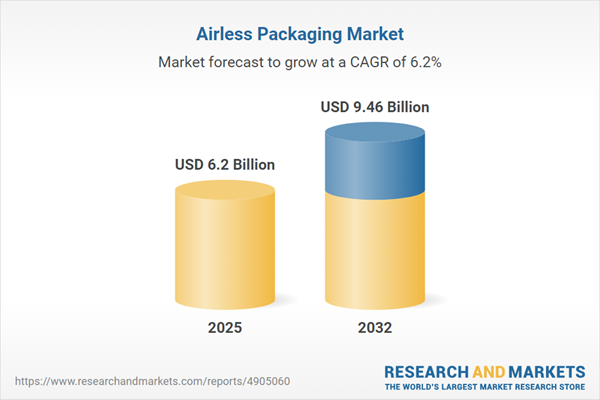Speak directly to the analyst to clarify any post sales queries you may have.
Airless packaging is transforming supply chain operations for companies navigating complex regulations and demanding product quality standards. Senior leaders focused on risk reduction and business resilience are increasingly adopting airless systems as part of a cohesive strategy to maintain compliance and adapt to evolving market requirements.
Market Snapshot: Airless Packaging Market Trends and Growth
The global airless packaging market is valued at USD 5.83 billion and is anticipated to grow to USD 6.20 billion by 2025. With a compound annual growth rate (CAGR) of 6.21% projected through 2032, the sector will reach USD 9.46 billion. Key growth drivers are the expanding use of airless solutions in cosmetics, pharmaceuticals, skincare, and food and beverage sectors. Industries seek to lengthen shelf life, enhance compliance management, and advance sustainability, pushing ongoing innovation in supply reliability and distribution efficiency. The market also responds to shifting consumer expectations around safe delivery and adherence to regulatory standards, keeping airless packaging highly relevant for manufacturers and distributors.
Scope & Segmentation of the Airless Packaging Market
- Container Types: Airless bottles, dispensers, and jars deliver controlled dispensing and product protection for cosmetics, pharmaceuticals, and foods, supporting hygiene standards and meeting compliance demands.
- Material Types: Glass, plastic, and metal containers are selected to ensure durability and help organizations meet recycling and sustainability goals, aligning with circular economy initiatives in packaging supply chains.
- Applications: Airless solutions are designed to safeguard sensitive contents in cosmetics, skincare products, and pharmaceuticals, allowing businesses to maintain alignment with regulatory frameworks and adapt to industry-specific compliance updates.
- Distribution Channels: Retail and digital commerce channels each enable rapid response to consumer buying trends and logistical shifts, supporting omnichannel strategies for effective global reach.
- Regions: Adoption is robust in the Americas, Europe, Middle East, Africa, and Asia-Pacific, where regulatory frameworks shape implementation. The US, China, and India set the pace for new technology introduction, while local adaptation meets region-specific requirements.
- Key Industry Stakeholders: Prominent organizations such as AptarGroup, Silgan Dispensing Systems, Berry Global, APackaging Group, TricorBraun, O.Berk Company, Quadpack Industries, Lumson, Kaufman Container, and Ramson Packaging design and supply airless solutions that shape the standard in B2B environments.
- Technology Focus: Developments in vacuum dispensers, modular recyclable formats, and smart labeling with NFC support real-time product authentication and enhance traceability, facilitating regulatory compliance and operational transparency.
Airless Packaging: Key Takeaways for Senior Decision-Makers
- Implementing airless packaging reduces cross-contamination and safeguards product quality, improving reliability from manufacturing through distribution.
- Advanced material selection helps companies respond to environmental targets, ensuring readiness for regulatory changes and strengthening their overall sustainability approach.
- Precision dispensing design limits waste and maintains consistent quality, essential in sectors where product assurance is a key differentiator.
- Integration with logistics practices enables organizations to build resilient operations capable of adjusting to supply chain interruptions or market shifts.
- Utilizing omnichannel strategies allows businesses to consistently meet regulatory requirements and serve diverse global customer bases through a unified approach.
- Smart supply chain technologies, including real-time verification features, increase procurement responsiveness and compliance monitoring across packaging processes.
Tariff Impact and Supply Chain Adaptation
- Diversifying supplier networks and adopting nearshoring helps maintain business continuity and keeps operations agile in changing tariff contexts.
- Applying digital risk management platforms expedites adaptation to new customs, tax, or border regulations, minimizing downtime and improving organizational compliance.
- Broadening material sources and supplier options provides the flexibility needed to respond to market changes and potential supply disruptions swiftly.
- Locating production and distribution assets strategically across key regions secures market access and optimizes end-delivery schedules, reducing supply chain uncertainty.
Methodology & Data Sources
This market report utilizes targeted quantitative and qualitative research, including executive interviews, facility assessments, and regulatory review. The blended methodology leads to actionable insights designed to guide confident decisions for market entry, expansion, or risk mitigation.
Why This Airless Packaging Market Report Matters
- Offers detailed segmentation and a rigorous review of emerging technologies, supporting informed decision-making for sensitive and regulated industries.
- Enables sourcing and operations leaders to proactively manage compliance and enhance supply chain transparency, promoting organizational resilience and agility.
- Provides a strategic foundation for updating business models and operational practices in fast-changing regulatory and competitive landscapes.
Conclusion
Airless packaging empowers organizations to fortify compliance and streamline supply operations. Insights from this report help decision-makers refine strategies to bolster product protection and drive lasting market success.
Additional Product Information:
- Purchase of this report includes 1 year online access with quarterly updates.
- This report can be updated on request. Please contact our Customer Experience team using the Ask a Question widget on our website.
Table of Contents
3. Executive Summary
4. Market Overview
7. Cumulative Impact of Artificial Intelligence 2025
Companies Mentioned
The companies profiled in this Airless Packaging market report include:- AptarGroup, Inc.
- Silgan Dispensing Systems
- Berry Global, Inc.
- APackaging Group
- TricorBraun, Inc.
- O.Berk Company, L.L.C.
- Quadpack Industries S.L.
- Lumson S.p.A.
- Kaufman Container Company
- Ramson Packaging
Table Information
| Report Attribute | Details |
|---|---|
| No. of Pages | 184 |
| Published | November 2025 |
| Forecast Period | 2025 - 2032 |
| Estimated Market Value ( USD | $ 6.2 Billion |
| Forecasted Market Value ( USD | $ 9.46 Billion |
| Compound Annual Growth Rate | 6.2% |
| Regions Covered | Global |
| No. of Companies Mentioned | 11 |









